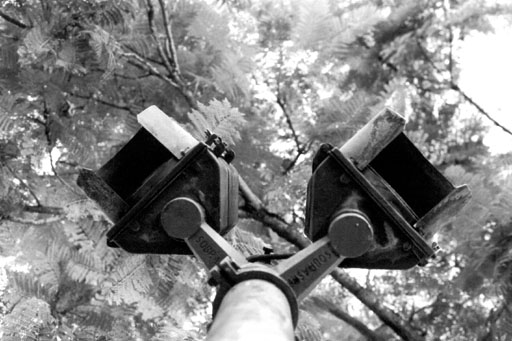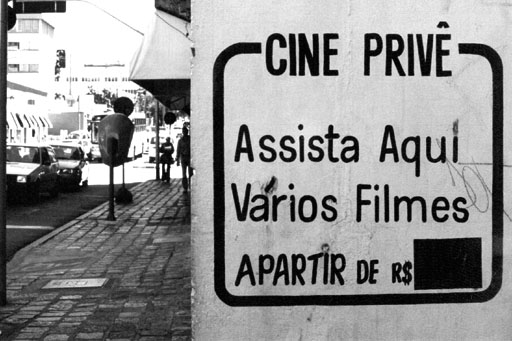
“A importância simbólica da encruzilhada é universal. Liga-se í situação de cruzamento de caminhos que a converte numa espécie de centro do mundo. Pois, para quem se encontra numa encruzilhada, ela é, nesse momento, o verdadeiro centro do mundo. Cada ser humano é, em si mesmo, uma encruzilhada onde se cruzam e se debatem os aspectos diversos de sua pessoa. Conhecemos, por exemplo, o tríplice aspecto de Afrodite, deusa uraniana, oceânica, ctoniana. Ela pode ser ao mesmo tempo a deusa casta, a deusa fecunda e a deusa lúbrica. E, precisamente nas encruzilhadas, é que ela se torna a deusa dos amores vulgares e impuros. Não é curioso observar, a esse respeito, que a palavra latina trivium significa encruzilhada, e que dela se originou o adjetivo trivial? A Afrodite das encruzilhadas (um dos lugares onde a deusa costuma deixar-se ficar) simboliza os amores efêmeros, transitórios.”


Do DicionÃ?¡rio de SÃ?Âmbolos,
de Jean Chevalier e Alain Gheerbrant;
com fotos de Sheila Gouveia.
Trevo, encruzilhada. Na umbanda a Pomba Gira habita as “encruzas” em forma de T, e Exu as em froma de + ou x
trivium significa “trÃ?ªs vias” em latim.
Ã?â?° tambÃ?©m “trivium” o nome que se dÃ?¡ ao conjunto das Sere Artes Liberais que, na Idade MÃ?©dia (e hoje ainda!), qualquer intelectual que se prezasse deveria dominar: gramÃ?¡tica, retÃ?³rica e lÃ?³gica.
——————————————-
The Medieval Trivium
by Tamara Mazzei
In the Middle Ages, a good university education included what were known as the Seven Liberal Arts, parts of which were adopted from ancient Greece. These were divided into the trivium (Latin – the three roads) and the quadrivium.
The trivium, said by John of Salisbury (in Metalogicon) to concern “the power of language,” referred to the study of grammar, rhetoric, and logic (dialectic). The quadrivium, on the other hand, which referred to the study of arithmetic, geometry, astronomy, and music, concerned “the secrets of nature.”
The arts of the trivium were considered a necessary base for mastering the arts of the quadrivium. It is worth noting that the arts of the trivium were more significant than merely learning to speak well and to use proper syntax, as the modern usage of the words might imply.
For example, the study of grammar, the most frequently taught because it was considered the most important, was subdivided into several areas: prose, meter, rhythm, and poetry. It entailed learning to create meaning from words, in addition to learning to use them properly. It was, in essence, very similar to what we think of today as the study of literature. Grammar was thought to give students a deeper understanding of the meaning of language and a greater ability to discern complex concepts as used in poetry and scripture.
Modern references to the medieval trivium often substitute the word “logic” for dialectic. In reality, though these words are interrelated, in this context they do not mean precisely the same thing. Dialectic is a form of reasoning that uses dialogue and debate (i.e., an exchange of ideas) to arrive at conclusions or “truths.” In the high Middle Ages, as a way of educating their students, university masters would engage in public debates on all manner of things, including theological questions. This practice, which had its origins in the ancient Greece of Aristotle, came to be called Scholasticism and was used by the Church to refute ideas considered heretical by using logic to expose “false” beliefs.
Rhetoric was a system of rules of ways of doing things that governed literary writing and formal speeches (sermons) that applied to both prose and poetry. The study of rhetoric taught students to focus on the style and the elements of discourse. e.g., arrangement, delivery, invention, style, memory. Some scholars also looked at the context of the speech such as whether it was meant for judicial, political or ceremonial purposes.
Rhetoric is frequently divided into the ars dictaminis (how to write letters – the oldest of the three divisions, dating from the eleventh century), the ars praedicandi (the srt of saying things, which is really about how to write a sermon) and the ars grammatica (grammar – which itself has several subcategories).
As the Middle Ages progressed, current knowledge increasingly extended the liberal arts and even fell outside the structure. The liberal arts, therefore, and philosophy as their foundation stone, should be regarded as building blocks, not as the sum of all Medieval learning. They represented the basic rounded education of a person with higher learning.
ponto para o dicionÃ?¡rio dos sÃ?Âmbolos: de fato, afrodites lÃ?ºbricas Ã?© o que mais tem nas encruzilhadas por aÃ?Â…
eu falei “sete” artes liberais e citei sÃ?³ trÃ?ªs, mas Ã?© que escrevi pensando tambÃ?©m nas do quadrivium (aritmÃ?©tica, geometria, astronomia e mÃ?ºsica).